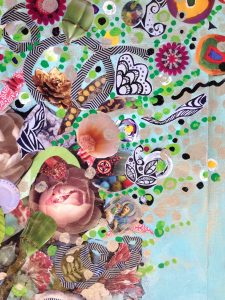You have a story to tell (and it lives in your body.)
As you know, I recommend writing as a way of healing. When we write story, we turn pain into beauty, even if we’re spinning complete fiction. Writing forces us to transform bits of disconnected ideas, pictures, sensations, and memories into episodic memory.
When a scene becomes worded completely, fleshed out with vivid details and thoughts, it becomes whole. We use both sides of our brains to create story: the emotions and colors live mostly on the right, while the words and logic live mostly on the left. We constantly move back and forth within the nervous system to pull pieces together like a patchwork quilt. This is information processing, the primary component of EMDR therapy.
Story and Information Processing with EMDR
Trauma memory tends to be stored in these separate, left and right, containers, which is why bits of it get activated without our realizing it. We become panicked all of a sudden when we drive through a particular part of town. We lose focus during a meeting and go numb in response to someone’s voice. We smell a particular perfume and get a guilt-attack…as if out of nowhere.
EMDR brings right and left together. Memory bits become clusters which become whole stories, complete with the necessary logic to neutralize their poison.
“I was four years old. Of course I wet my pants in the car! That’s what four-year-olds do!”
Through bilateral stimulation (BLS), EMDR triggers the integration of the panic, guilt, shame, pictures, sensations, temperatures, muscle tensions, and beliefs with newer knowledge about ourselves and the world. “I’m defective…” becomes “I’m normal…I did the best I could.”
When our story becomes whole, we can tell it thoroughly and artfully. We can even rewrite it to tell a bigger story or turn it into the story we wish we’d experienced in real life. We can turn trouble into art. This is why I wrote Wife Material, my semi-autobiographical novel of growing up in religious abuse.
Information Processing with Exercise
Last week, I wrote about how exercise transforms our mental state. I think this happens through bilateral stimulation. In EMDR, we use side-to-side eye-movements, pulses, auditory tones, or taps for this. But running, walking, punching, crawling, and climbing can do something similar. This is probably why a good power-walk blows out tension and cobwebs and shines light on all kinds of things you haven’t seen in a while. It moves you beyond your day’s troubles and stuck thoughts and pushes you into an altered brain – a brain that sees and interprets differently…a brain alive with story.
This spring, I’m opening a therapy office at The BodySmith, where I’ll join a team of skilled and caring fitness professionals. We’ll collaborate to find more ways to help you keep things moving: to transport old trauma out of its disconnected storage bins and into creative, working memory.
For now, try this exercise and let me know how it works for you.
- Make a list of issues you’re worried about. Place a star beside the one bothering you most.
- Notice any emotion or body sensation you get with that issue.
- While you’re still aware of the issue, take a long walk, 30 minutes or more. Allow your mind to wander while you walk.
- Afterwards, get your notebook and write about the issue again. Notice any changes in perspective or feeling.
Call me if you’d like to talk about how to tell your story and use EMDR and exercise to heal.
[dacta]


Like to Subscribe?
Get notified when Deborah shares new ideas, art, and creative health information for you.
You have Successfully Subscribed!
We respect your privacy. No information will be shared.